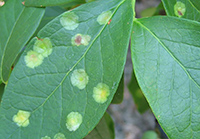The key to managing Exobasidium leaf and fruit spot disease in blueberries, which makes the fruit unmarketable, is one application of lime sulfur approximately two weeks prior to bud break, according to Jonathan Oliver, University of Georgia Cooperative Extension fruit pathologist.
Exobasidium disease causes spots on the leaves and fruit, decreases the fruit’s size and, because of the fruit’s immaturity, gives it a bitter taste. The leaf spots eventually turn velvety and white and lead to early defoliation, and the spotted fruit is not fit for sale.
Blueberry plants are currently dormant — they’re alive, but not actively growing. Oliver, who specializes in small fruits, believes that lime sulfur, a chemical spray used to control insects and fungi on fruit trees, can reduce the amount of inoculum carried over from the previous growing season. The application of lime sulfur will reduce disease occurrences for the upcoming year, he said.
“This has the potential to almost completely control in-season Exobasidium disease on both the leaves and fruit,” Oliver said.
Blueberry producers hope to rebound from a devastatingly low crop in 2017 due in large part to a late-season freeze last March. The freeze suppressed Georgia’s blueberry production, and growers lost about 70 percent of their crop.
Georgia has experienced several bouts of freezing temperatures this winter, but those temperatures haven’t affected the still-dormant plants. Once the plants emerge from dormancy this spring, blueberry producers hope to avoid any subfreezing temperatures.
The colder temperatures this winter may have a positive impact on reducing some blueberry diseases. In warmer temperatures, certain fungi can grow on leaves in greater numbers throughout the winter. This proliferation makes some diseases worse and allows them to occur earlier in the spring.
“The colder weather we have been having should help to somewhat reduce, but not eliminate, carryover inoculum for some foliar diseases. However, other fungal diseases will be unaffected by the colder weather,” Oliver said.
This year, growers must remain aggressive with fungicide spray programs because carryover inoculum will be prevalent in plantings that were not sprayed or well maintained in 2017, Oliver said.
There are additional measures that blueberry producers can take to reduce disease pressure. Excessive water in the root zone is a key component in the development of root rot disease. Growers can reduce this threat by using raised beds to ensure that there’s adequate drainage and by planning proper irrigation for blueberry fields.
Some diseases, like mummy berry, overwinter on infected berries. Growers can decrease the risk of this disease by burying or removing infected berries from the field, but these measures will not eliminate the disease, Oliver said.
“Typically, in the warm, humid conditions of south Georgia, many fungal diseases can be devastating if not properly managed,” Oliver said.
Georgia is the country’s No. 1 producer of blueberries. According to the UGA Center for Agribusiness and Economic Development, the statewide 2016 farm gate value for blueberries totaled $283.8 million. Blueberries accounted for 38.1 percent of Georgia’s fruit and nut production.








